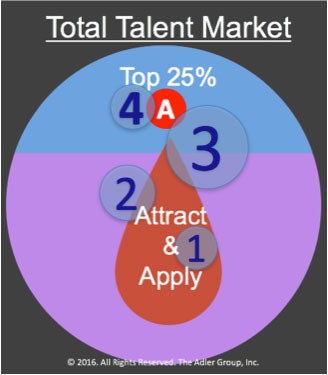The Sourcing Plan That Will Help You Recruit the Elusive Top 25% of the Talent Market
Take a look at this image:
This represents the total talent market for any given job. The “A” represents a small group of qualified prospects, mostly passive -- about 25% of your prospect talent pool. Most will call you back right away because they were referred. Most of the rest will call you back because they see your opening as a possible career move.
These are the prospects I call “Recruiter’s Gold.” And, it takes some skill to find these golden nuggets. Before we dive into how to find them, lets consider the other groups of talent.
The breakdown of talent tiers
As you examine the treasure map, note that the best prospects are represented by the blue upper quartile. The teardrop represents the typical distribution of people who apply to a job posting. Note that just a few are in the upper quartile.
Group 1 represents a subset of applicants who possess all of the criteria on the job description and have been filtered on compensation, location and title. Rarely will you find A-level talent responding to a job posting for a critical job.
Group 2 represents candidates who have been direct sourced (searching through resume databases like LinkedIn and contacted via email) using Boolean in combination with LinkedIn Recruiter’s filtering system. The reason this group isn’t comprised of more top quartile candidates is that they have been selected based largely on their level of skills and experiences. Given this as the criteria, few top people respond to the messaging since they’re not interested in considering jobs that represent lateral transfers.
Group 3 represents a highly talented group of direct-sourced candidates. The reason there are more top tier prospects in this pool is that the search criteria used to find them is based on performance qualifications and achievement terms, not skills and experiences. As important, when the messaging emphasizes career growth and an opportunity to discuss the opportunity rather than applying directly, response rates are far higher.
Group 4 is the “Recruiter’s Gold” group of prized candidates. They’re preselected, highly referred and performance qualified prospects who would see the job as a career move. The reason they’re golden is that they always call you back.
How to recruit the top 25% of the talent market
Given the above treasure hunting guidelines, I suggest recruiters implement a 40-40-20 sourcing plan. Basically this suggests spending 40% of your time networking to get names of gold tier candidates, spending another 40% of your time direct sourcing performance and achievement qualified candidates and spending the remaining 20% writing job postings and recruiting messages that will appeal to gold tier candidates. The reason the postings are important is that you’ll drive all of your direct sourced candidates to these jobs so they need to be compelling.
While all of this sounds great, these four tipping points represent the difference between success and failure:
1. The big shift
You must get the hiring manager to shift from a skills and experience qualification criteria to one based on performance, achievement and potential. Performance qualified means they can do the work. The big point of this is that if they can do the work they must have all of the skills necessary or learn them quickly, but often this is a different mix than what’s on the job description.
2. Guerrilla marketing
You need to use a multi-pronged marketing campaign to get at least 50% of the Group 3 direct sourced candidates to respond to your message. This requires a combination of emails, tweets, videos and voicemails that are customized for the job describing compelling job-branded opportunities.
3. The 30% solution
Once on the phone, recruiters must convince more than 50% of the Group 3 and Group 4 people who respond that the job represents a career move. If the job turns out not to be a good fit, the recruiter needs to obtain at least one referral of another gold tier prospect.
It’s important to tell these prospects that a career move requires a minimum non-monetary increase of at least 30% consisting of some combination of a bigger job, faster growth, more impact and a richer mix of more satisfying work. This is often all that’s needed to get the person to explore the opportunity.
4. Networking wizardry
It’s easy to get great referrals from your co-workers. Just proactively search on their connections for top tier people and ask if the person is worth contacting. You can use the same approach with any of your first degree connections and those Group 3 prospects who aren’t perfect fits. Just connect with them and search on their connections and also ask, “Who’s the best person you’ve ever worked with doing this type of work?”
There is golden talent out there. However, you need a great map and a skilled prospector to find and recruit them. If you’ve ever worked with a gold tier person you know it’s worth the hunt.
*Image from Indiana Jones and the Raiders of the Lost Ark
To receive blog posts like this one straight in your inbox, subscribe to the blog newsletter.
Topics: Sourcing
Related articles





